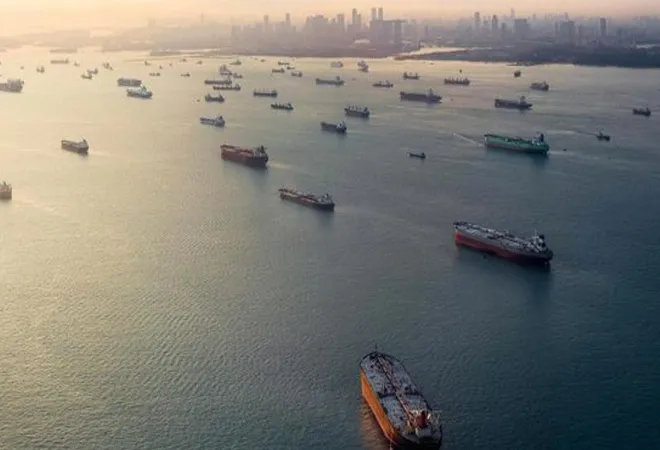
The Tsushima strait, also known as the Eastern Channel of the Korea Strait, sits at a critical crossroads of Northeast Asia, which is home to some of the world's largest economies, such as Japan, South Korea, and China. The
243-kilometre-long Tsushima Strait is a narrow waterway that connects South Korea and Japan, two key middle powers in the Indo-Pacific, and acts as a point of entry to the Sea of Japan, which some see as a strategic backdoor to Russia and China. It is a
crucial maritime passage for all four countries and shipping routes connecting Asia to Europe pass through it, making it significant in the geopolitical landscape of Northeast Asia, with millions of tons of cargo passing through it each year. This makes it an important chokepoint for global trade, particularly for the G20 nations, which collectively account for around
75 percent of global trade. Because ROK and Japan agreed to a
3nm territorial sea (instead of 12nm per the UNCLOS), 17nm of the 23nm wide Strait is designated as international high seas.
The strait also serves as a major transit route for military vessels and aircraft, and it is a critical location for surveillance and intelligence gathering. In addition to its economic, security, and cultural importance, the Tsushima Strait also has significant environmental significance. The strait's unique geography and ocean currents make it an essential habitat for a diverse range of marine species. The strait is home to many endangered species, including the Korean sturgeon, the Japanese eel, and the Black Sea bream. The strait's waters are also a crucial spawning ground for many fish species, making it an essential area for fisheries and aquaculture.
The strait's unique geography and ocean currents make it an essential habitat for a diverse range of marine species.
Who is the Strait important for?
Prima facie, the Tsushima Strait is most important as the primary marine route for Japan's oil imports. The Tsushima Strait is crucial for the country's energy security as more than
90 percent of Tokyo's oil and gas imports pass through this strait. Japan's economy is significantly dependent on oil imports, and almost all of this oil comes from the Middle East, travelling through the Strait of Malacca and the South China Sea before crossing the Tsushima Strait and entering the East China Sea. As a result, any interruption to the oil flow via the strait might substantially impact Japan's economy and energy security. Japan's western ports, including Fukuoka, are connected to the rest of the globe via the Tsushima strait and form a crucial part of the
SLOCs between Honshu and Kyushu, and trade routes from the Seto Inland Sea, via the nearby Kanmon Strait. Japan's
Maritime Safety Agency is responsible for patrolling and protecting the waters around the strait, ensuring the safety and security of Japanese citizens and assets.
South Korea's economy is heavily dependent on maritime trade, with the bulk of its exports and imports transported by sea via the Tsushima Strait, especially to Japan, China, and Southeast Asia. The majority of South Korea's shipping routes pass through the Tsushima Strait,
particularly trade with the United States (US) West Coast ports like Seattle and San Francisco. Tsushima Island, which lies at the centre of the strait, has a long history of cultural and economic exchange with the Korean Peninsula. The island played a significant role in the relations between Korea and Japan during the Choseon Dynasty and has been the site of several historic battles.
The Tsushima Strait's strategic position as a gateway to the Sea of Japan and the Pacific Ocean is among the most important factors contributing to its significance to the US.
The Tsushima Strait is crucial for maintaining the region's peace and security because the US is a significant ally of Japan. The Tsushima Strait's strategic position as a gateway to the Sea of Japan and the Pacific Ocean is among the most important factors
contributing to its significance to the US. Being the entry point for the US military forces and supplies into Japan and also for the maintenance of its military presence in South Korea since the Korean War, these ports and the Strait are extremely important to the US. The latter, therefore, has an interest in maintaining freedom of navigation in the strait, ensuring the safe and uninterrupted movement of its naval assets.
The Strait is a crucial shipping route for China's trade with Japan, South Korea, and other regional nations. As a trading country that primarily relies on maritime transportation to get its products to markets all over the world, the strait is a vital transit route for China. The Strait is crucial for China's naval strategy in Northeast Asia as it allows Beijing to
project its naval force beyond its immediate coastline.
China along with Russia has repeatedly pushed the limits of freedom of navigation and maritime sovereignty in the Tsushima strait just as Beijing has done in the South and East China Seas.
The Tsushima Strait is an important strategic location for Russia’s
naval access to the Pacific Ocean. Due to its direct access to East Asian markets, the strait is also a significant trading route for Russia. Exports of Russian gas and oil to South Korea, China, and Japan must cross the strait to get there. The Tsushima Strait is also important for Russia's diplomatic ties with Japan. The Kuril Islands, which are managed by Russia and are located to the north of Japan, are the subject of a protracted territorial dispute between the two nations.
The Strait is crucial for China's naval strategy in Northeast Asia as it allows Beijing to project its naval force beyond its immediate coastline.
Threats, mitigation, and partnerships
The Tsushima Strait faces five major threats which have scope for mitigation through cooperation. First, the narrow and busy strait is susceptible to maritime accidents such as collisions and groundings that could lead to
oil spills and other environmental disasters. To reduce the risk of accidents and incidents, the countries in the region have set up a system for the exchange of information on maritime traffic and weather conditions. To increase maritime safety and stop such accidents, the nations have also established protocols for incident reporting and investigations.
Second, there are ongoing territorial disputes between Japan and South Korea over the ownership of several islets in the strait. These disputes have the potential to escalate into armed conflicts, which could threaten the safety and security of the strait. The dispute over the Liancourt Rocks has a long history dating back to the early 20th century and has broader implications for the relationship between Japan and South Korea, and also for regional stability.
Climate change has the potential to cause significant changes to ocean currents and weather patterns, which could affect the safety and navigability of the strait.
Third,
North Korea's military activities pose a significant threat to the strait. The country's navy is known to conduct submarine operations in the area, and its missile tests have also been launched from the region, raising concerns about the safety of shipping in the area. Fourth, the strait is a vital fishing ground, and illegal fishing by Chinese and North Korean vessels has been a persistent problem. This not only threatens the sustainability of the fisheries but also poses risks to the safety of legitimate fishing vessels. Fifth, climate change has the potential to cause significant changes to ocean currents and weather patterns, which could affect the safety and navigability of the strait. Rising sea levels and increased storm activity could also lead to coastal erosion and damage to critical infrastructure such as ports and shipping lanes. Countries in the region have established a mechanism for the monitoring and management of marine pollution, including oil spills and other hazardous substances, including the establishment of response plans and the coordination of resources and personnel to minimize the impact of pollution on the marine environment.
For boosting maritime security, a shared platform for exchanging
intelligence and coordinating responses to security threats has been established by the region's nations. This includes the coordination of naval patrols and surveillance operations as well as the sharing of information on piracy, smuggling, and other security issues.
The strategic importance of the Strait as a vital maritime shipping route is heightened in the context of the uncertainties posed due to geopolitical tensions between the US, China, and Russia which in turn could also intensify pre-existing tensions among Japan-ROK; Japan-Russia; and Japan-China. Ensuring safe and free passage via the Tsushima Strait is, therefore, an important component of maritime security efforts which are part of the Indo-Pacific frameworks of cooperation.
The views expressed above belong to the author(s). ORF research and analyses now available on Telegram! Click here to access our curated content — blogs, longforms and interviews.



 The Tsushima strait, also known as the Eastern Channel of the Korea Strait, sits at a critical crossroads of Northeast Asia, which is home to some of the world's largest economies, such as Japan, South Korea, and China. The
The Tsushima strait, also known as the Eastern Channel of the Korea Strait, sits at a critical crossroads of Northeast Asia, which is home to some of the world's largest economies, such as Japan, South Korea, and China. The  PREV
PREV


